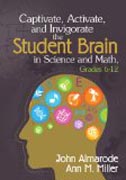
Captivate, Activate, and Invigorate the Student Brain in Science and Math, Grades 6-12
Almarode, John T. (Taylor)
Miller, Ann M. (Marie)
Get your students excited about science and math! Are your lessons falling on unengaged ears? Maybe it’s time to mix things up! John Almarode and Ann Miller provide numerous strategies and a model for developing engaging science and math lessons and units that captivate students, activate prior knowledge, and invigorate student interest by making lessons rigorous and relevant. Based on the latest brain research, this book includes: -Content-specific lessons plans and strategies for middle and secondary school teachers -Useful forms and supplements for each strategy -Examples across all areas of middle and high school math and science, including physics, algebra, and chemistry -Lesson plan templates to get you started INDICE: ForewordPrefaceAcknowledgmentsAbout the Authors1. The Recipe for an Engaged Brain The Recipe for Student Engagement Recipes as Frameworks Using Your Engagement Monitor Engagement: An Overt and Covert Operation You Can Lead Students to Class, but Can You Make Them Think? Chapter 1: 3-2-1 Exit Ticket Engaging Professional Development Tasks References Engaging Professional Development Tasks2. Building Background Knowledge Using Models to Build Background Knowledge A Road Map of the Brain The Nuts and Bolts Engaging the Students With Vocabulary Pandora's Box Chapter 2: Concept Development Exit Ticket Engaging Professional Development Tasks References3. Prime the Brain: Activate Prior Knowledge The Deafening Sound of Silence Making Student Brains More Efficient Getting Better Encoding, Retention, and Recall Link to the Recipe for Engagement Chapter 3: Fist List Exit Ticket Engaging Professional Development Tasks References4. Captivate With Novelty In the Classroom, Novelty Is the Spice of Life Emotionally Charged Events Goldilocks and the Three Bears: Novelty in Moderation Chapter 4: Exit Ticket Engaging Professional Development Tasks References5. Why Do We Need to Know This? Establishing Relevance How Is Relevance Good for the Brain? A Mouse Tale How Can I Make Learning Behaviorally Relevant? Link to the Recipe for Engagement Chapter 5: Exit Ticket Engaging Professional Development Tasks References6. Too Much, Too Fast: Maintaining an Engaging Pace Input and Quantity Limitations Press and Release What to Do Between Chunks? Too Much, Too Fast Chapter 6: Exit Ticket Engaging Professional Development Tasks References7. Make Learning a Long-Lasting, Invigorating Experience It's as if They Were Never Even in Class Checking for Understanding Reading Closure Activities A Watched Pot Never Boils . . . and This Is a Good Thing Chapter 7: Exit Ticket Engaging Professional Development Tasks References8. Building an Engaging Science or Mathematics Lesson and Unit Using the Recipe to Build an Engaging Lesson Using the Recipe to Build an Engaging Unit A Recipe for Diversity Taste Testing the Recipe Chapter 8: Exit Ticket Engaging Professional Development Tasks ReferencesAppendix A Unit Instructional PlanAppendix B Daily Lesson PlanIndex
- ISBN: 978-1-4522-1802-1
- Editorial: Corwin
- Encuadernacion: Rústica
- Páginas: 224
- Fecha Publicación: 14/05/2013
- Nº Volúmenes: 1
- Idioma:
